

8 Extra Meridians. 12 Standard Meridians. The Meridian System of the Body. Qi Meridians and Acupuncture points - General Discussion - The Dao Bums. Qi meridians and resevoirs 8 pieces of brocade Chi Kung video clipYouTube - Qigong: Eight Piece Brocades Chi Kung Video of the real 6 healing sounds-YouTube - Qigong Chi Kung: Six Healing Sounds 5 animal frolic Chi Kung video-YouTube - Qigong Chi Kung: Five 5 Animal Frolics Dragon and Tiger Medical Chi Gung- Here are 2 really good sites about acupuncture site about meridiansWing Chun Kwoon Basic heavenly circuit meridians, Ren and du, or cenception and governing, circulating/orbiting in the front and the back The Large meridian orbit circulates along the arms and legs, along the yin side to the yang side, inside arms and legs, and outside arms legs.
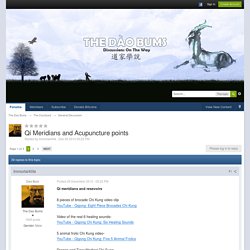
Meridian (Chinese medicine) The meridian system (simplified Chinese: 经络; traditional Chinese: 經絡; pinyin: jīngluò, also called channel network) is a traditional Chinese medicine (TCM) belief about a path through which the life-energy known as "qi" flows.[1][2][3][4] A 2001 review found little evidence to support the existence or function of qi or acupuncture meridians.[5] However, more recent studies confirm that the meridians and acupoints have many biophysical properties such as electric, thermal, acoustic, optical, magnetic, isotopic, and myoelectric characteristics, which are different from those of non-acupuncture points.[6] The meridian network is typically divided into 2 categories, the jingmai (經脈) or meridian channels and the luomai (絡脈) or associated vessels (sometimes called "collaterals").
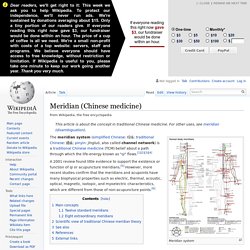
Find Acupuncture Points location, description and picture. Acupuncture Charts. List of acupuncture points. System of main meridians with acupuncture point locations This article provides a comprehensive list of acupuncture points, locations on the body used in acupuncture, acupressure, and other treatment systems based on Traditional Chinese Medicine (TCM).
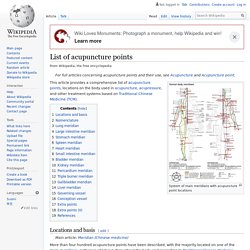
Locations and basis[edit] Although many hypotheses have been proposed, the anatomical and physiological basis for acupuncture points and meridians remains elusive.[2] Hypotheses include neural signaling, with possible involvement of opioid peptides, glutamate, and adenosine, and correspondence to responsive parts in the central nervous system; or mechanical signaling, with involvement of connective tissue (fascia), and mechanical wave activation of the calcium ion channel to beta-endorphin secretion.[3] In practice, acupuncture points are located by a combination of anatomical landmarks, palpation, and feedback from the patient.[1] Twelve Primary Meridians: Eight Extraordinary Meridians 奇 經 八 脈 (奇 经 八 脉), qí jīng bā mài (qí jīng bā mò):
Acupuncture point. Despite considerable efforts to understand the anatomy and physiology of the "acupuncture points", the definition and characterization of these points remains controversial.[1] "There is ... no compelling scientific evidence for the existence of either meridians or acupuncture points.
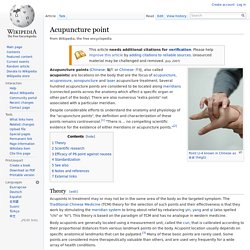
"[2] Theory[edit] Points tend to be located where nerves enter a muscle, the midpoint of the muscle, or at the enthesis where the muscle joins with the bone.[4] Location by palpation for tenderness is also a common way of locating acupoints (see also trigger point). Points may also be located by feeling for subtle differences in temperature on the skin surface or over the skin surface, as well as changes in the tension or "stickiness" of the skin and tissue. Body acupoints are referred to either by their traditional name, or by the name of the meridian on which they are located, followed by a number to indicate what order the point is in on the meridian.
Scientific research[edit] Acupuncture Points Database - Locations, Functions and Clinical Usage. Acupuncture Point Location. Stomach channel of Foot Yangming (Bright’ Yang) 45 Spleen channel of Foot Tai Yin (‘Greater’ Yin) 21 Heart channel of Hand Shao Yin (‘Lesser’ Yin) 9Heart 7 Shenmen Spirit Gate Small Intestine channel of Hand Tai Yang (‘Greater’ Yang) 19 Bladder channel of Foot Tai Yang (‘Greater’ Yang) 67Bladder Point 1 - Jing Ming - Bright EyesBladder Point 23 Shen shuBladder Point 67 - Zhiyin - Utmost YinKidney channel of Foot Shao Yin (‘Lesser’ Yin) 27 Pericardium channel of Hand Jue Yin (‘Absolute Yin) 9 Pericardium 6 - Neiguan - Inner Frontier Gate San Jiao channel of Hand Shao Yang (‘Lesser’ Yang) 23 Gallbladder channel of Foot Shao Yang (‘Lesser’ Yang) 44 Liver channel of Foot Jue Yin (‘Absolute Yin) 14Liver 8, Ququan Conception Vessel.
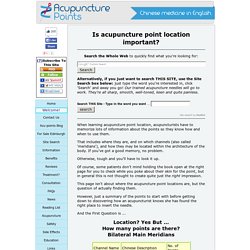
Acupuncture Meridian and TCM Posters. Acupuncture and Meridian Charts. Governing Vessel Meridian The Governing Channel has 28 points. Governing Vessel Meridian Pathway & Point Locations The Governing Channel has 28 points The Du channel starts midway between the tip of the coccyx bone and the anus with patient lying prone.
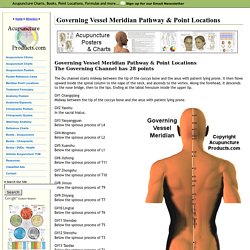
It then flows upward inside the spinal column to the nape of the neck, and ascends to the vertex. Along the forehead, it descends to the nose bridge, then to the lips. 20 Acupuncture Points Every Martial Artist Should Know: Part 1 – Internal Arts International. A basic knowledge of acupuncture points (acu-points) is an invaluable tool for the martial artist.
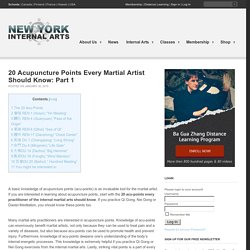
If you are interested in learning about acupuncture points, start with the 20 acu-points every practitioner of the internal martial arts should know. If you practice Qi Gong, Nei Gong or Daoist Meditation, you should know these points too. Many martial arts practitioners are interested in acupuncture points. Knowledge of acu-points can enormously benefit martial artists, not only because they can be used to treat pain and a variety of diseases, but also because acu-points can be used to promote health and prevent injury. Furthermore, knowledge of acu-points deepens one’s understanding of the body’s internal energetic processes. My observation is that a lot of martial arts practitioners begin to learn about points and then quickly give up, because the science of acu-points seems like a difficult and insurmountable task.